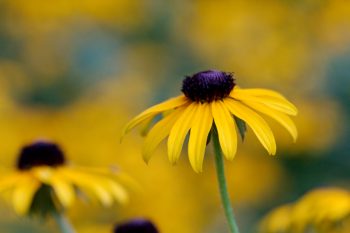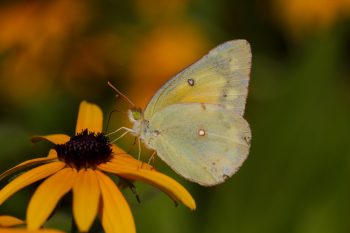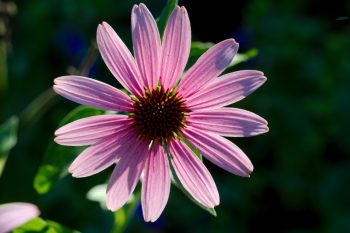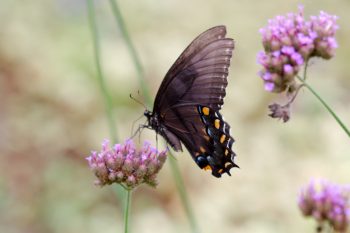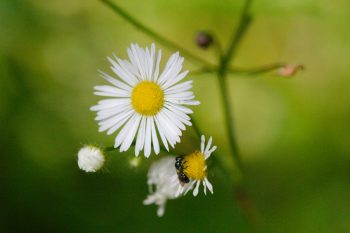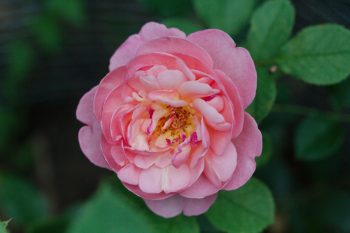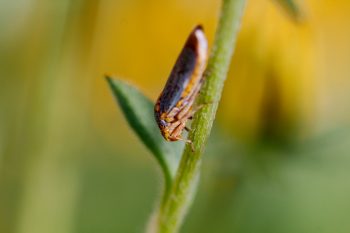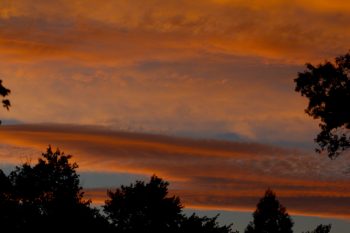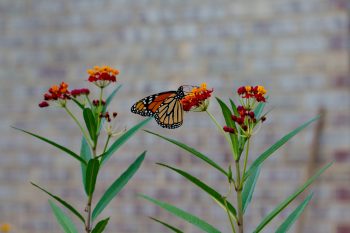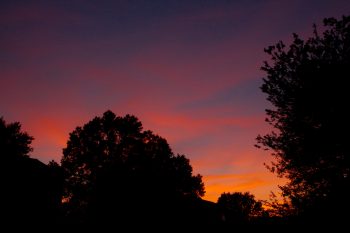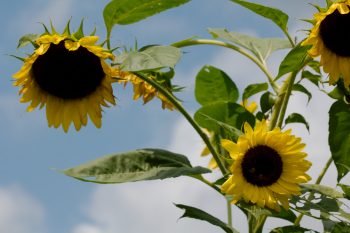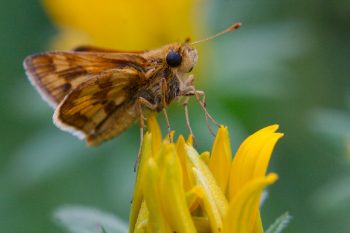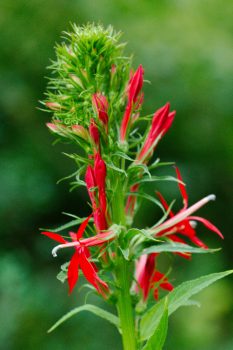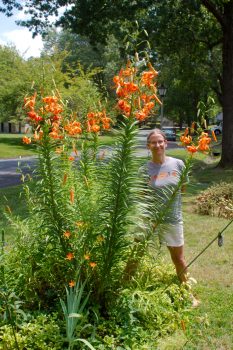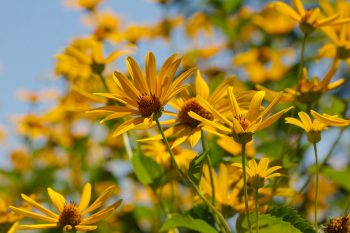Our yard is pretty heavy on the Rudbeckias, (black-eyed Susan) although we’ve actually gotten rid of a few. You probably wouldn’t notice and it’s going to take a bit more work if we’re actually going to cut back on them noticeably. On the other hand, this time of year, they really are wonderful in their great numbers. The insects like them, although perhaps they aren’t the favorite flower. The skippers in particular are to be found on them and that’s where I usually see transverse flower flies (Eristalis transversa).
Black-eyed Susan
Orange Sulphur
I’m not actually 100% sure of the identification of this sulphur. It may be an orange sulphur (Colias eurytheme) but it’s hard to tell for sure from the underside of the wings. It’s a sulphur, anyway, subfamily Coliadinae. I’ve had a hard time getting a good photograph of one, as they are quite shy and often don’t land when I’m near by. So, I was pleased to get this photo and a few others today. It’s a pretty little butterfly and I love seeing them on the flowers in the yard.
Backlit Coneflower
The coneflower (Echinacea purpurea) is in our back garden near the back fence. In the late afternoon, backlit by the sun it’s quite lovely. The bees, particularly carpenter and bumble bees, seem to really like the coneflowers. We (and by we I mostly mean Cathy) did a lot of work in this part of the garden this summer. It had become quite overgrown with mugwort and goldenrod among the monarda, asclepias, and irises. It’s basically ready for new plants now, so it isn’t finished, but it’s so much better than it was.
Tiger Swallowtail (Papilio glaucus)
We have a lot of tiger swallowtails (Papilio glaucus) in our yard. The particularly like the butterfly bush (Buddleia) but we see them on other flowers, as well. They are often quite ragged, with torn wings and sometimes with less than half remaining. Nevertheless, they seem to get around alright. Most of them are the standard yellow striped with black but we have a significant number of the dark form, which is restricted to females of the species. This is a pretty nice one, with her wings mostly intact. As you can see, she is on a tall verbena (Verbena bonariensis).
Fleabane (Erigeron)
We walked another section of the upper Rock Creek trail today. We parked at Redland Middle School and went from there to Lake Needwood. This section of trail is mostly level with just a little up and down. It follows the creek and included crossing Muncaster Mill Road. Although there is a crosswalk, you pretty much have to wait for someone actually paying attention who stops, as they are supposed to do. The path and creek also go under the Intercounty Connector (MD 200). Our walk was about 2.5 miles round trip, although it didn’t actually feel like we went that far. I was nice to be in the woods, although the humidity was very high and we were pretty well drenched by the time we got back to the car.
Eloise
Cathy and I went to see Iris and Seth’s new baby this afternoon. Naturally we stayed outside, but I was still able to take a few photographs. Silas didn’t want to take his mask off so although I got a few of Iris and Seth with Eloise sans mask, the full family grouping is all masked up. I think it’s a pretty cute picture, although without context, in years to come, someone is going to wonder why they were wearing masks. Anyway, mother and daughter (and father and brother) are doing well.
Canna Leaves
I took Dorothy to the airport this morning. It was raining so the traffic was a bit slow but other wise no problem. It continued to rain the rest of the day and I only got out for a little while to take pictures. These are canna leaves with water droplets on them. The canna is (her the Missouri Botanical Garden’s Plant Finder):
a genus of around 10 species of rhizomatous, tropical and subtropical, herbaceous perennials that produce flower spikes in summer atop erect stems sheathed in large paddle-shaped leaves. Cultivars are available with colorful foliage and flowers in a range of warm colors including red, orange, yellow, pink, and creamy white.
Rose ‘Boscobel’
This is the third of my three new roses planted this year. This isn’t its first bloom although it did take longer than the other two did to bloom. That has more to do with the rabbits nipping off the buds than anything else. It now has a hardware cloth fence around it and it’s doing much better. This one is planted near the back fence and should be visible from the house once it gets a bit taller. I have high hopes for all three of these roses and was glad to get them planted back in mid-May.
Oncometopia orbona (Broad-headed Sharpshooter)
I took some photos of flowers today as well as a few of tiger swallowtails. But then I saw this little insect. It’s a leafhopper and they aren’t very big. I got two decent photos of it, one with the head and eyes in focus (this one) and the other with the body in focus but the head blurred. Nevertheless, it was enough to let it be identified as a Broad-headed Sharpshooter (Oncometopia orbona). There are four species of Oncometopia in the U.S.A. but this is the only one that’s known to be present here, so I’m pretty sure that’s right. It’s a pretty little critter.
Another Sunset
We’ve done well in terms of sunsets lately. Here is the third in a week. I don’t know, honestly, if they actually come in bunches or I simply happen to notice them in bunches. Either way, I’m happy to have them whenever we do. This one was really nice, with parts of the sky a mix of deep blue with a thin layer of magenta/orange over it. Hard to describe and hard to photograph. This shot was taken to the northwest and I like it quite a bit. Just above the orange band at the top, the sky was a more uniform color. I took a few with my wide angle lens but the orange colors in this part were a bit washed out.
Monarch on Butterfly Weed
The monarch (Danaus plexippus) is one of the prettiest butterflies we get. They don’t show up in nearly as great numbers as do the tiger swallowtails (Papilio glaucus) and maybe that’s what makes their appearance more exciting. This one was on a tender butterfly weed (Asclepias curassavica) that it in a container on our back patio. I took this one photo from the lawn side of the patio before trying to get around to the other side. Just as well because it flew off after that and I got no more. I did take some more photos of the tiger swallowtails but I’m sure I’ll get more of them this summer.
Sunset
We had another lovely sunset this evening. This shot is from out back yard, looking northwest. Looking due west we mostly have trees, so the best we can do is either northwest or southwest. They were both nice this evening but northwest was better, I think. There was also a bright orange/magenta streak almost directly overhead. I’m not sure if it was the remains of a contrail, but it really didn’t look like it. I got a few pictures of that, as well.
On other matters, we drove to West Springfield this afternoon to have an outdoor supper with a dear friend. It was so good to see another person in real, 3D life.
Sunflowers
It was very hot today, and quite muggy, but Cathy and I have been trying to get out on the weekend, at least for a little while, regardless. We went tot he Mont. County Agricultural Farm Park today and walked on one of the trails for a while. Parts were in the shade but even then it was so humid that we were pretty well drenched with sweat. Nevertheless, it was good to be out. We also walked through their demonstration garden again. It wasn’t a lot different to the last time we went but I got a few more pictures, including a few of these sunflowers against the sky.
Clouds at Dusk
Cathy and I took a walk in the neighborhood after dinner. Thunder was rumbling as we left the house and we didn’t know if we’d get rained on before we were home again but we decided to risk it. We were glad we did. Not only did we not get rained on but we were treated to some wonderful clouds. They ranged from blue grey to bright orange and a few were the purest white. It was quite lovely. We also saw rain but it was probably a mile or so away. The thunder continued to rumble, but it was blue overhead.
Polites peckius (Peck’s Skipper)
The skippers are here in their great numbers. They aren’t flashy like the swallowtails and they don’t buzz like the bees, but they are everywhere. They especially like the black-eyed Susan flowers (as seen here) and the Verbena bonariensis but they can also be seen on other plants. This is, I believe, a Peck’s skipper (Polites peckius), also known as the yellow patch or yellow spotted skipper. The larvae feed on grasses while the adults take nectar from flowers. They are widespread across much of North America.
Cathy’s Patio Garden
It’s summer here in Maryland and with it come the summer colors. Cathy often plants containers with a mixture of annual and perennials plants for the patio but this year I think she’s outdone herself. The patio is surrounded by black-eyed Susans (Rudbeckia) and that adds quite a nice backdrop to all the containers. To Cathy’s left, above the red tea pot, are cana lilies and a beautiful, bright red Pelargonium (a.k.a. geranium). The yellow and orange in the lower middle are purslane and there’s more of that in the bottom right, hear the elephant’s trunk. The hanging basket in the upper left is Lantana camara. As you can see, there’s a fair amount going on in the large, central bed. The garden against the fence has been dug out and almost completely restarted. It should be nice in a year or two, though.
Bicyrtes quadrifasciatus
This is a sand wasp, Bicyrtes quadrifasciatus I believe. It’s fairly common although nothing like the western honey bee or the bumble or carpenter bee, but I see them quite a bit on the mountain mint (Pycnanthemum muticum), as this one is. If I go out in the heat of the day, with the sun beating down on the mountain mint, it’s an absolute hive of activity (and I mean that in the most literal sense). There are myriad bees and wasps buzzing around with an occasional skipper sneaking in. The buddleia above has mostly bumble and carpenter bees as well as butterflies. Now and then I spot a true bug of one sort or another. It’s really wonderful, unless of course you are allergic or simply afraid of stinging things. It’s also very hot so I don’t generally stay out too long, but I love it.
Cardinal Flower (Lobelia cardinalis)
I probably should have waited a little longer to take a picture of this, since it isn’t really in full bloom yet. But I only got outside for a little while late this afternoon and this is all I took photos of. Cardinal flower (Lobelia cardinalis), is an American native and well worth growing. It really adds a splash of bright color to the garden. The only thing here is that you need to watch it in our dry summer heat that it doesn’t dry out too much. It likes moist soil and can even tolerate a little brief flooding. If you’re in a place that’s not quite so hot in the summer, you could plant it in full sun but for us, it does better with a bit of shade. This one is growing under a largish cherry tree and it a bit protected from the hot, afternoon sun. If you have a stream or pond, this would be great on the banks of that. Ours will have more flowers in a matter of days but you can already see how red the blooms are and why it’s such a nice thing in the border. We should have more than we do.
Cathy and Tiger Lilies
When I posted the close up of the tiger lily a couple days ago, I knew it wouldn’t be the only tiger lily photo I’d post this summer. They’re simply too nice to get just one mention. Dad had these growing in the garden along the driveway. Quite a few years ago we took some of the bulbils that form in the leaf axils on young stems. I find it interesting that they seem to form on young stems and not on the more mature stems. Generally you think of a more mature plant yielding more of this sort of thing. But I suppose the more mature stems produce a lot more seeds, so they don’t need to do this.
Anyway, we have them well established in a few places in the yard and they are magnificent. This is the biggest and most successful bunch, growing in a bed where a dead oak tree was removed a while back, out near the road. As you can see, they’re about eight feet tall and really happy in this sunny location. I recommend them pretty highly. The tiger swallowtails seem to like them, as well.
Summertime
We’re in the heart of summer. We’ve had over three weeks of daytime high’s over 90&#b0;F and it approached 100°F today with even higher temperature forecast for tomorrow. In spite of the heat, Cathy and I felt like we really needed to get out. The Montgomery County Farm Park seemed like a good destination. Their demonstration garden was very nice. It’s a bit overgrown with weeds but since it’s not our responsibility, that bothered us less than weeds do at home. I think these are some sort of wild sunflower but there are quite a few plants with this basic look and I didn’t see a label on them. Regardless, this is summer. Big, bright, bold, yellow flowers against a beautiful, clear, blue sky.

